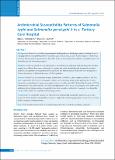Please use this identifier to cite or link to this item:
https://hdl.handle.net/20.500.14356/1943Full metadata record
| DC Field | Value | Language |
|---|---|---|
| dc.contributor.author | Raza, S | - |
| dc.contributor.author | Tamrakar, R | - |
| dc.contributor.author | Bhatt, C P | - |
| dc.contributor.author | Joshi, S K | - |
| dc.date.accessioned | 2023-06-02T06:12:25Z | - |
| dc.date.available | 2023-06-02T06:12:25Z | - |
| dc.date.issued | 2012 | - |
| dc.identifier.citation | RazaS., TamrakarR., BhattC. P., & JoshiS. K. (2013). Antimicrobial Susceptibility Patterns of Salmonella typhi and Salmonella paratyphi A in a Tertiary Care Hospital. Journal of Nepal Health Research Council. https://doi.org/10.33314/jnhrc.v0i0.335 | en_US |
| dc.identifier.issn | Print ISSN: 1727-5482; Online ISSN: 1999-6217 | - |
| dc.identifier.uri | http://103.69.126.140:8080/handle/20.500.14356/1943 | - |
| dc.description | Original Article | en_US |
| dc.description.abstract | Abstract Background: Enteric fever is still an important public health problem in developing countries including Nepal. A changing antibiotic susceptibility pattern of Salmonella typhiand Salmonella paratyphi  A and emergence of multi drug resistance has increased to a great concern. Aim of the study was to investigate the antibiotic susceptibility pattern of Salmonella typhiand Salmonella paratyphi A. Methods: Study was carried out at the department of microbiology in Kathmandu Medical College. Blood culture samples were collected from suspected enteric fever patient and tested microbiologically by standard procedure. Antibiotic susceptibility test was performed by Kirby-Bauer disc diffusion method and results were interpreted by National Committee for Clinical Laboratory (NCCLS) guideline. Results :Of total 78 (2.0%) Salmonella serotype isolated from 3,980 blood culture samples, in which 47 (60.3%) were S. typhiand 31 (39.7%) were S. paratyphi A. Isolates were from all age group median age being the 25 years. Among the tested antibiotics S. typhi was susceptible towards Ciprofloxacin (100%) followed by Gentamicin (97.9%), Of loxacine (95.7%), Ceftriaxone (95.7%) and Chloramphenicol (93.6%). In case of S. paratyphi A most of the testedantibiotics showed high percentage of susceptibility and least susceptible antibiotic for S. paratyphi Awas Ampicillin (25.8%). Three isolates of S. typhishowed multidrug resistance. Conclusions: A considerable variation was observed in the antimicrobial susceptibility pattern of S.typhi and S. paratyphi A. Hence antibiotic susceptibility test must be sought before instituting appropriate therapy to prevent from further emergence of drug resistance. Keywords: antimicrobial sensitivity test; ciprofloxacin; enteric fever; multi-drug resistance; salmonella. | en_US |
| dc.language.iso | en | en_US |
| dc.publisher | Nepal Health Research Council | en_US |
| dc.relation.ispartofseries | Sep-Dec, 2012;335 | - |
| dc.subject | Antimicrobial sensitivity test | en_US |
| dc.subject | Ciprofloxacin | en_US |
| dc.subject | Enteric fever | en_US |
| dc.subject | Multi-drug resistance | en_US |
| dc.subject | Salmonella | en_US |
| dc.title | Antimicrobial Susceptibility Patterns of Salmonella typhi and Salmonella paratyphi A in a Tertiary Care Hospital | en_US |
| dc.type | Journal Article | en_US |
| local.journal.category | Original Article | - |
| Appears in Collections: | Vol. 10 No. 3 Issue 22 Sep - Dec, 2012 | |
Files in This Item:
| File | Description | Size | Format | |
|---|---|---|---|---|
| 335-Article Text-334-1-10-20130823.pdf | Fulltext Download | 195.01 kB | Adobe PDF |  View/Open |
Items in DSpace are protected by copyright, with all rights reserved, unless otherwise indicated.
